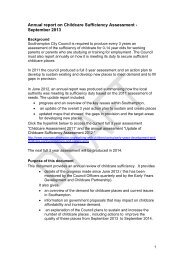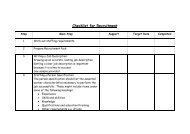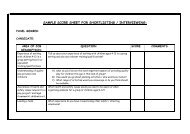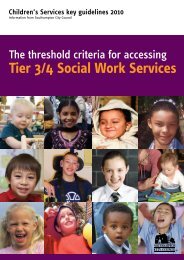Proposed structure for the Children and Young People's Workforce ...
Proposed structure for the Children and Young People's Workforce ...
Proposed structure for the Children and Young People's Workforce ...
- No tags were found...
Create successful ePaper yourself
Turn your PDF publications into a flip-book with our unique Google optimized e-Paper software.
2010- Work<strong>for</strong>ce Strategy Draftii.Integrated WorkingIntegrated working is a central part of <strong>the</strong> ECM agenda <strong>and</strong> <strong>the</strong> One <strong>Children</strong>’s Work<strong>for</strong>ceFramework.There are a number of integrated working tools, guidance documents <strong>and</strong> work<strong>for</strong>cedevelopments available which support integrated front line delivery of children’s services.These include:• Common Assessment Framework (CAF) – The CAF provides a st<strong>and</strong>ardisedapproach to carrying out an assessment of a child's additional needs. CAF is ameans to identify <strong>and</strong> support children with additional needs <strong>and</strong> <strong>the</strong> most vulnerablechildren who may not yet have accessed specialist support.• In<strong>for</strong>mation sharing- practitioners need to underst<strong>and</strong> when, why <strong>and</strong> how <strong>the</strong>yshould share in<strong>for</strong>mation in 2006 HM Government in<strong>for</strong>mation sharing guidance(2006) was produced <strong>for</strong> practitioners across <strong>the</strong> children’s work<strong>for</strong>ce. This guidancehas been updated (2008) to extend its relevance to practitioners working with adults<strong>and</strong> families.• Lead professional- The lead professional is a key element of effective frontlinedelivery of integrated children’s services. It ensures that professional involvement isrationalised, co-ordinated <strong>and</strong> communicated effectively.• Multiagency working- Multiagency working is an effective way of services workingtoge<strong>the</strong>r to support children, young people <strong>and</strong> families with additional needs.Different models of multiagency working include Team Around <strong>the</strong> Child (TAC), fullyintegrated services, locality teams <strong>and</strong> multiagency panels.• Common Core of Skills <strong>and</strong> Knowledge- sets out <strong>the</strong> basic skills <strong>and</strong> knowledgeareas needed by all people (including volunteers), whose work brings <strong>the</strong>m intoregular contact with children, young people <strong>and</strong> families.• Leadership <strong>and</strong> management- “Championing <strong>Children</strong>”, “The Hay Group report: Thetraining <strong>and</strong> development of middle managers in <strong>the</strong> <strong>Children</strong>’s Work<strong>for</strong>ce” <strong>and</strong>“Leading <strong>and</strong> Managing <strong>Children</strong>’s Services in Engl<strong>and</strong>: A National ProfessionalDevelopment Framework” offer guidance <strong>and</strong> support <strong>for</strong> leaders <strong>and</strong> managers,including those working in integrated settings. Nationally work is being undertaken toadvise <strong>the</strong> DCSF on a strategy <strong>for</strong> leadership <strong>and</strong> management <strong>for</strong> <strong>Children</strong>’s Trustpartners <strong>and</strong> <strong>the</strong> development of <strong>the</strong>ir middle managers.• Common induction st<strong>and</strong>ards- The CWDC induction st<strong>and</strong>ards set out what newworkers should know, underst<strong>and</strong> <strong>and</strong> be able to do within six months of startingwork. They are now m<strong>and</strong>atory <strong>for</strong> <strong>the</strong> children's social care work<strong>for</strong>ce but areappropriate <strong>for</strong> use across <strong>the</strong> work<strong>for</strong>ce.• Integrated Qualifications Framework (IQF)- The IQF will be a set of approvedqualifications that allows progression, continuing professional development <strong>and</strong>mobility across <strong>the</strong> children <strong>and</strong> young people's work<strong>for</strong>ce.• Diploma <strong>for</strong> <strong>the</strong> <strong>Children</strong> <strong>and</strong> <strong>Young</strong> People’s Work<strong>for</strong>ce –The CWDC is developing anew Level 3 diploma <strong>for</strong> <strong>the</strong> children <strong>and</strong> young people's work<strong>for</strong>ce, set to start incolleges in September 2010. This will replace existing Level 3 qualifications in earlyyears, social care <strong>and</strong> learning development support services. The qualification ispart of <strong>the</strong> council's work to rationalise <strong>and</strong> clarify qualifications under <strong>the</strong> newQualification <strong>and</strong> Credit Framework (QCF).iii.The 2020 <strong>Children</strong> <strong>and</strong> <strong>Young</strong> People’s Work<strong>for</strong>ce StrategyThe 2020 <strong>Children</strong> <strong>and</strong> <strong>Young</strong> Peoples Work<strong>for</strong>ce Strategy, produced by <strong>the</strong> Department <strong>for</strong><strong>Children</strong> Schools <strong>and</strong> Families (DCSF), describes how <strong>the</strong> Government <strong>and</strong> partners willwork toge<strong>the</strong>r to ensure that everyone in <strong>the</strong> work<strong>for</strong>ce receives <strong>the</strong> support <strong>and</strong>Version 2.6 33
















